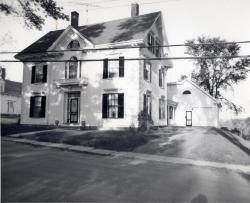
The Overlock House, Thomaston, ca. 1960
Thomaston Historical Society
During the mid 19th century, Knox Street, formerly known as Knox’s Lane or driveway, became a public street when portions of the Knox estate were sold to private developers. James Overlock (1813-1906) came to Thomaston from Waldoboro in 1836, and apprenticed as a ship’s carpenter and house joiner with Robert Cushing. When Cushing died in 1840, Overlock, after building a house for himself on Knox Street, set up his own house building business.

Edward W. Robinson House, Knox Street, Thomaston, Maine c. 1870
Thomaston Historical Society
His styling and detailing changed as new tools and machinery became available. New to the market were jig saws and circular saws, which were used to make decorative treatments in moldings, brackets, dentils, and window and balcony details. He popularized the inverted fleur-de-lis symbol, using it lavishly in side porches, an Italianate architectural element. By the 1850s, he made a personal statement by moving into a higher style two-and-a-half storey home on Knox Street, which had a rusticated treatment on the front facade. Rustication was a technique of cutting and beveling wooden siding boards at intervals to simulate stone blocks. Oftentimes, sand was applied with paint to imitate the texture of stone. Both Mount Vernon and Monticello have this feature. Overlock built many grand Italianate homes throughout Thomaston as well as earlier styles, and owned or held mortgages on several others.